A noted Korean folk religious leader
By Lee Kyung-sik, Cho Kyung-hee, Paul Kim
The Korean people, from thousands of years ago or perhaps from time immemorial, have a unique traditional folk religious rite named Gut (Good, Goot or Kut). The rite is performed by Mudang or Munyeo (male or female shaman), and it involves offerings and sacrifices to gods, spirits and ancestors.
The Gut rites are characterized by rhythmic movements, songs, oracles and prayers. These rites are meant to create welfare, promoting commitment between the spirits and mankind. The major categories of rites are the Naerim-gut, Dodang-gut and the Ssitgim-gut.

Through the use of songs and dances, the performer (shaman) begs the gods to intervene in the fortune of men. The shaman wears a very colorful costume, and normally speaks in ecstasy.
During a rite, the performer changes his or her costume several times. Rituals consist of various phases, called Geori.
Purity of both the body and the mind is a state that is required for taking part in rituals. Purification is considered necessary for an efficacious communion between living people and ancestral forms. Before any Gut is performed, the altar is always purified by fire and water, as part of the first Gori of the ritual itself.
The color white, extensively used in rituals, is regarded as a symbol of purity. The purification of the body is performed by burning white paper.
In January this year, a noted Korean folk practitioner, Mudang Gumpa, stunned many Koreans, if not the world, with an outstanding Korean folk rite at the Carnegie Hall in New York. Following this performance, Gumpa received an invitation from Washington and Paris to present his performance there.
The Arirang Good (Gut) Concert of Gumpa, thus, is spreading far and wide to many capitals around the world as well as in Seoul, which sheds spotlight on the traditional culture of Korea, the folk religion, in particular.
With such outstanding performance across many countries, Gumpa now is acknowledged not only as renown shaman but also as an international art performer.
The Korean folk rite presented by Gumpa was the popular Korean shaman rite originated in the Hwanghae Province of Korea and therefore it is called “Hwanghae Gut.”
Gumpa also has special regard for the United States and other United Nations Forces personnel who died during the Korean War for the cause of justice and freedom of the Republic of Korea and the world. Recently, Gumpa donated to the Association of the Korean War Veterans in the United States.
In recognition of Gumpa’s special regard for the U.S. Forces Korean War veterans, Congressman Gerry Connolly presented Gumpa with a Letter of Appreciation and an Honorary Citizenship of the New York State.
Gumpa studied performing art and music at the Seoul Institute of the Arts majoring in performing art and music. Before he became a Korean folk religious practitioner, Gumpa had toured all parts of Korea presenting his songs and music and also released an album.
Gumpa studied Hwanghae Provincial Shaman Rite performances for six years from three noted Korean folk religious performers. The Hwanghae-do Gut rite consists of three different categories, namely City Rite for the city people, Mountain Spirit Rite for the mountain deities and the Ship Rite for the sea deities of the Dragon Palace under the sea.
The Korea Post media, publisher of 3 English and 2 Korean-language news publications since 1985, recently interviewed Gumpa for detailed information him and his activities. Here are excerpts from the the questions and answers exchanged with Gumpa:
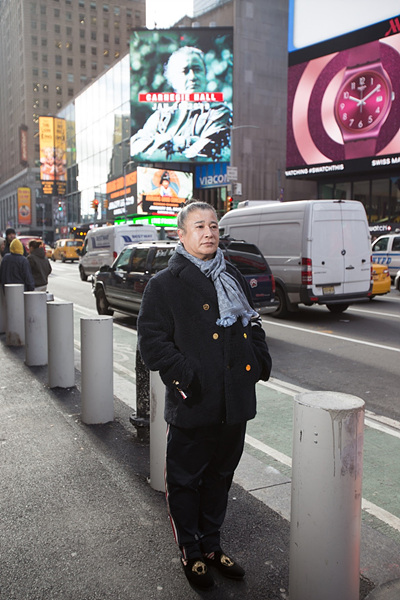
Question: We understand that you specialize in Hwanghae-do Provincial Gut rite. Please introduce your activities.
Answer: If you take a close look at Hwanghae-do Gut, you can see that it's a prototype of the Korean art. If you follow the tradition, Samulnori (Korean traditional percussion quartet), you come close to the Hwanghae-do Gut rite, and the Kim Duk-soo Samulnori team is famous. Before you make a Samulnori team, you should master Hwanghae-do Gut rhythm.
Artistic, musical and theatrical parts are all in Hwanghae-do Gut, and the total prototype of the dance in Buddhist attire, Salpuri (exorcism), Samulnori, music, art, and costumes is Hwanghae-do Gut.
It is taking root, deep and sound in Korean society.
It's the 20th year of my shaman's life. When I first came across the Hwanghae-do Gut, I felt that this is art, although the shaman holds a religious rite because I originally majored in theater at Seoul Institute of the Arts.
So I thought that I had no choice but to face this path and I wanted to stage it a little. The reason why I tried to stage it stemmed from the fact that the image of shamanism is a bad one in Korea.
I wanted to use the name Mudang Gumpa and describe it as an artistic aspect, not a religious one. It is because the culture of this rite continued until the Joseon Dynasty.
Until the Joseon Dynasty, we had held village festivals before doing farming such as Ganggang Suwollae (a Korean ring dance) and farmers' band. It developed into the Daedong Gut, which lasted for three nights and four days. When the Japanese came in, however, they disliked it and started to destroy our ethnicity and destroy it.
Politically until the end of the government of President Park Chung-hee, the government had wiped out superstitions and many Gut rites. Since then, we have various human cultural asset Gut practitioners in the country, ranging from Western Gut to Hanyang (Seoul) Gut. I personally think it's a religious ritual, but many people think it's not that, but that it is pseudo superstition, and I thought I should put it up from the dark to the sun, and so I started performing the Gut rites.
Anyway, I was going to the shaman's path. That's how I got started. As a result, I was on the stage at Gwanghwamun Square in front of the old Capitol Building in Seoul once or twice, but it didn't go on continuously. When I was doing a Gut through translation at Gwanghwamun, I got a bit political.
Q: We hear that you had many Gut performances in foreign countries. Would you like to introduce them?
A: Since they recognized me in foreign countries, I've done a lot on foreign stages since the beginning of this year, and foreigners even recognize this culture as a religious aspect.
I'm going to bring the Gut with me, but this rite shows our traditional art culture to the world. I stood on the stage of the Carnegie Hall, New York, on Jan. 26 this year.
Under the title of "Arirang Concert of Mudang Gumpa," I had the Gut performance at Carnegie Hall where only world-famous international artists could stage their work. On March 23, I also performed at the National Mall in a park of Washington D.C. in the U.S. I performed the Hwanghae-do Gut there.
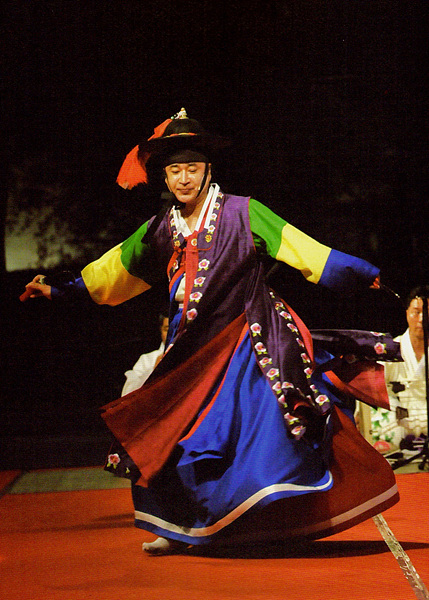
A religious and artistic performance at the National Mall was for the first time for a Korean. The backdrop was the Capitol, where the U.S. Presidents held their inaugural ceremony. So I finished the performance while watching the Lincoln Center. On November 30 this year, I will perform at Lincoln Center in New York.
The audience in the U.S. said that the Hwanghae-do Gut performance was wonderful, especially in terms of the rhythm, costumes, movements, lines, and the dance. Even though they are Catholics, they said, "It is art, don't look at it as a religious activity."
In the case of the performance at Lincoln Center, there were military generals, some 50 general-grade officers of the U.S. military when we presented our performances on Nov. 30.
On July 27, 2019, I was invited as a VIP under the name of "Mudang Gumpa" to the 66th anniversary of the End of the Korean War, and sat with the Korean ambassador to the U.S., Chairman Kim Jin-ho of the Korean Veterans Association, and other general-grade officers.
In Korea, no matter how hard I try, I can't escape from the title of shaman, so I'm going abroad now. In July this year, I tried to hold a performance in Paris in France. Since there are so many events and complexity in France, I gave up and held three events in the U.S. In the case of next year, I'm going to have Gut performance in Australia. I have a thought, "As the world recognizes shamanism, let's recognize it in Korea."

Q: I hear that you have won many traditional culture and art awards in recognition of your contribution to heralding Korea's tradition and culture. Would you introduce them?
A: I received the Gumpa Traditional Culture Award, and will get a cultural achievement award at the Korea-China International Film Festival on Oct. 26. I get a cultural achievement award. By the way, the Korea-China International Film Festival is a film festival that will be broadcast live through CCTV in China.
Accordingly, I am getting recognition from those people in China and I hope that the general public will think that the shaman's rite is now part of promoting our culture around the world.
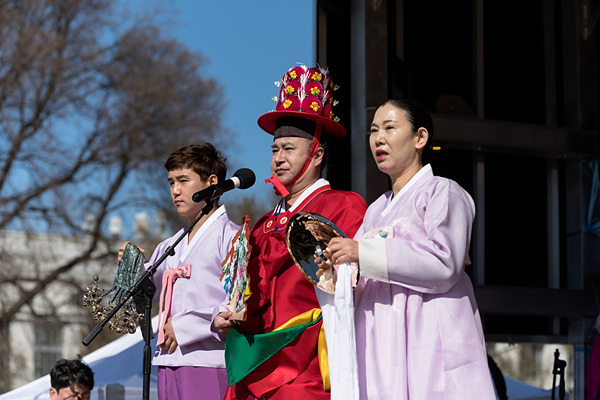
When I performed at the Lincoln Center, guests were Koreans, foreigners who are interested in the Gut, Korean War veterans, living people who participated in the Korean War, and soldiers.
What's special about my performance is that I sing a song, "Arirang" at the finishing time in a foreign country. When I traveled to China in the past, I watched a performance and heard the Arirang melody.
When I heard the melody of Arirang there, I could see the spirit of Dangun, the legendary founding father of Gojoseon era, not to mention that of South and North Korea.
As the melody remains in our hearts when we are Koreans, the motif during my performance is always Arirang. When I do this, people from all over the world can sympathize with me. In the case of the Korean War veterans, they miss Korea because they participated in the Korean War.
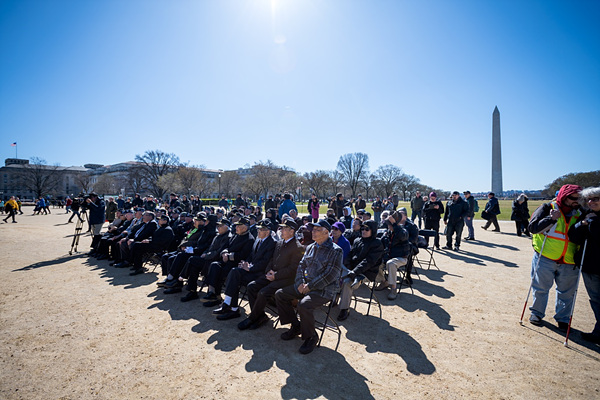
Q: We'd like to know how you connect Arirang and the Hwanghae-do Traditional Gut. Please mention about this.
A: What's unique compared to other shamanic people is that I majored in theater. So I hope we can combine Arirang and the Hwanghae-do Traditional Gut in an artistic way at a certain stage.
In a way, it's not the right part. But it works because it is Han (resentment). Our traditional art comes from Han. Arirang is also Han and Gut itself is Hanpuri (venting one's resentment)." And when you do a ritual to achieve your wish, you get in touch with it through Hanpuri.
The most widely known Korea's tune (melody) in foreign countries is the Arirang tune, so no matter how BTS becomes familiar, it's not as good as our Arirang. So, I think that Arirang can be the motif of the world.
That's why we're doing Arirang Gut. There are a lot of overseas Koreans coming. Also, if I sing Arirang, it will make all Koreans cry.
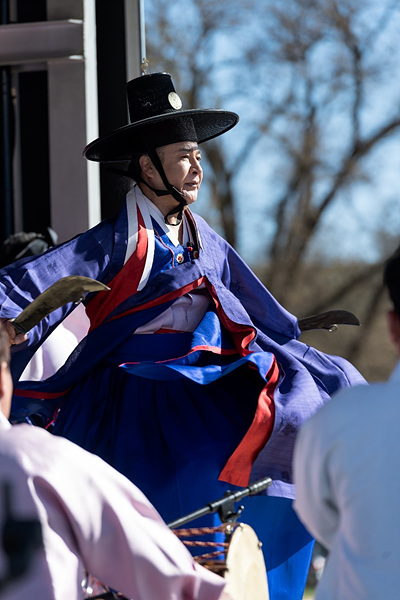
Q: You said you will have a performance at the Lincoln Center for the Performing Arts on Nov. 30. If you have any other plan to perform, please let us know.
A: Following the performances in Seoul, New York, Carnegie, Washington, Lincoln Center, I'll go back to Seoul City to have a Arirang concert, and then I hope to visit North Korea to perform in Pyongyang or Gaeseong.
In the case of Pyongyang or Gaeseong, the culture was preserved as it was during the Goryeo Dynasty. Since the tombs of Dangun Grandfather and Taejo Wang-geon of the Goryeo Dynasty were preserved in the same state, they were registered on the UNESCO.
Under the topic of "Peaceful Unification," I am preparing for Gut performance in Seoul and a city in North Korea further.

Q: Do we have to learn traditional Gut to become a shaman?
A: In case of Hwanghae-do Gut, you need to learn traditional techniques or etiquette of a long time ago, but you need to have a real natural talent to express Hwanghae-do Gut. You can't learn five or ten years without the natural talent. In other words, you have to be born to perform the Hwanghae-do Gut properly.
The name "Mudang" originally known to be found in the history of Dangun Wanggeom, the progenitor of the Korean nation. Then, it means that holding a rite for the people in the sky is a shaman. Shaman perform both the traditional Korean folk religious rites and fortune-telling.
In my case, before I became a shaman, I wrote the Bible nine times during 10 years of my church service. When I went to church, the dialect (gift of tongues) was exploded from my tongues. I think it was made as I went to church, so I did it in the name of Jesus. The place where the dialect came out the most is the Full Gospel Church.
I also served as a senior member of the church named Nammyohorengekyo for 10 years. And then I became a shaman. In 2008, I folded up everything. I was in the mountains for about three years. And I started praying for a change of fate, and it made me what I am today.
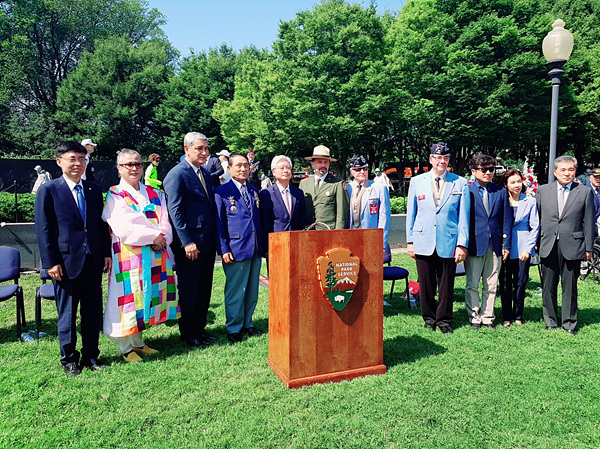
Q: Would you introduce how to pray for changing the fate?
A: People are born and live according to their destiny. It's destiny whether live a happy life or an unfortunate one. However, people can go up a notch higher from there through this prayer method, even though they cannot change the date of birth. The people can say to themselves as follows:
“I can go up depending on how I pray. If I go up, my life itself will be upgraded. For example, I was heartbroken by my husband or kids. It's all my fault. It's the fate that I'm destined to meet such a husband and kids. I'm destined to follow this fate.”
Then can God change it? Will Jesus Christ change it? Or will Buddha do it? They can't change them.
“I” have to change them. How do “I” change them?
We need to change the life in ourselves. What is life? Jesus himself said that there is heaven and hell in the people’s mind. Buddha also taught you, Find the Buddha in yourselves.”
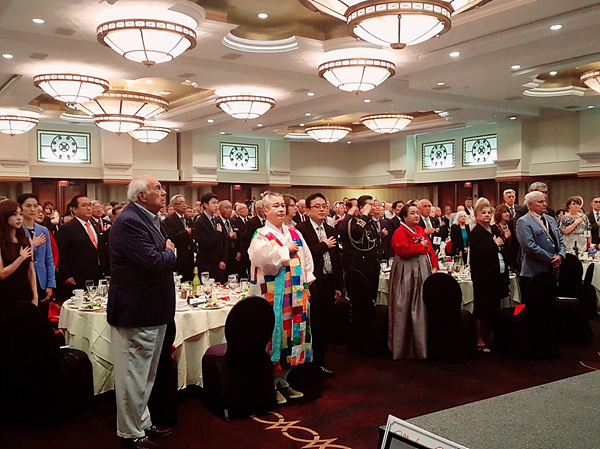
Although I'm wearing a rind called Mudang Gumpa, there's always a life I can go with when my body is ‘dead.’
Even if I am born as a dog in the next life, life is life. That's where we start. There's life. Since I was born, you can stay with me anyway. This is the heart.
Because I've sinned in my past life, so I'm having a hard time in this life. Whatever I did wrong, I'm looking for it. I'm the only one who can do it, meditating... Wipe this mind up.
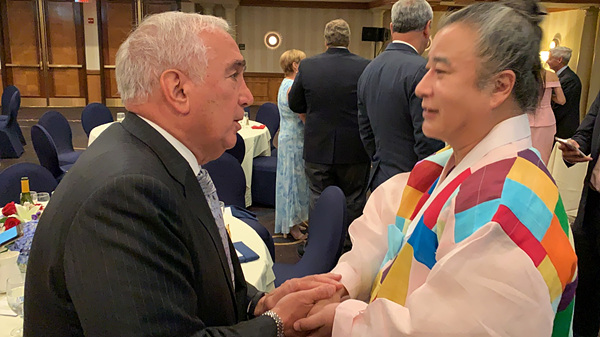
Q: Does Mudang Gumpa believe in the ancestral gods?
A: No. It is a Dangun Wanggeom in my house. The Dangun Grandfather is our ancestor. People say, "It is a superstition, but it was originally started from Dangun."
Why did Jesus come to the world here? The doctrine of religion requires the people to eat well, live well and be happy. Why would they rape and kill women in India and Nepal when there's Buddha's law there? There's a law about Jesus. Why was there a religious war since the Middle Ages? It's all about blood. It's the same now.
Did you see Dangun Grandfather starting a war? It is a humanitarian ideal to give benefit to the people widely, stressing love, mercy, and life itself.

The churches were first brought in by Japan during the Japanese colonial period. So they spread out the churches in our country and remove the priestly offerings and the feast from us.
The shaman here knows that if one sins, one will be punished immediately, so one will not do anything of which one will be guilty. If you don't know a crime, you're going to find it here in the shaman. The way to do that is to look at your past life. You can see it in this way.
It's about an individual looking for this past life in his or her life. If you find out how to pray, you can pass it on to your offspring so that everything will be done well.

Q: I think that you've come to your own way in a right method now. Do you think so?
A: Until I became myself now, I had many rituals with a pastor, priest or monk. I think I've turned my fate in the sky. My life was so tingling and I had to starve for three days. It's crazy for people who are struggling in front of me.
For instance, we can see Actress Choi Jin-sil's case. A year after the actress committed suicide, her brother committed suicide and her husband committed suicide two years later. Her daughter is also now suffering from lymphoid disease. That's the karma. They believed in God very faithfully.
But originally, they were the people who believed in Gut. It is because they betrayed their ancestors. If I wanted to make money, I could switch to church. Under the title that the shaman returns to the church, I could make a lot of money. But I will live as a shaman and die.
Q: There are many forms of folk religious rites in Korea. Please introduce yours.
A: I more or less specialize in the Hwanghae-do Gut. Hwanghae-do is a province now mostly belonging to North Korea. It is also known as Gangsinmu, according to the Encyclopedia of Korean Folk Culture, which is performed by a shaman practitioner who is capable of trance channeling, who has been initiated into the calling through a possession ritual (Naerim Gut) after experiencing spirit sickness.
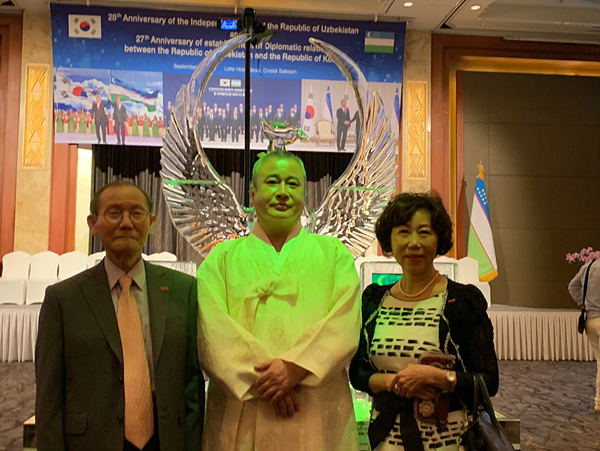
Shaman Mudang Gumpa was born in Sokcho, Gangwon Province in 1966. When he was in the sixth year grade at a primary school, he moved to Seogwipo, Jeju Island, the hometown of his parents. After finishing middle and high school in Jeju Island, he majored in theater at a university. In 1988, he worked on his solo album through Taekwang Music Album and became a singer.
He was a devout Christian who entered Christianity from middle school to college and served in the military, but changed to Nammyohorengekyo (a Japanese-originated religious belief) to serve as a senior member of the church for the peace of his family after he was discharged from military service.
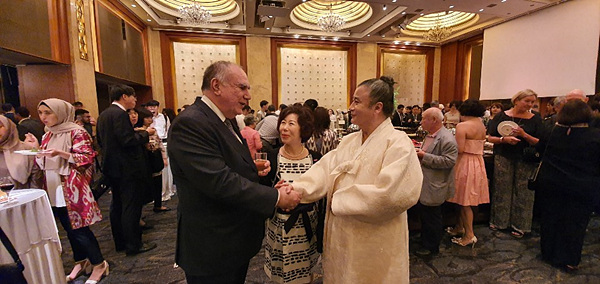
However, during the wandering due to questions about the nature of life, he had a spiritual experience in 1999. In May 2000, he was given a rite of exorcism as Hwanghae-do Gut and walked the shaman's path.
As a special talent of Hwanghae-do Gut, he was invited to the World Ceramic Expo Festival in Icheon, Gyeonggi Province in July 2001 to perform at a traditional art. Since then, he performed a series of Gut performances, including a performance at the request of the Traditional Art Newspaper in 2002, a performance of Hwanghae-do Gut for traditional art in 2003 and a consolation rite for Hwanghae Province Gut Senior Mudang in February 2004.
In March 2005 in Phuket at the invitation of the Tourism Authority of Phuket, Thailand, he performed the shamanistic rituals for the tsunami victims. In April 2005, he performed Gut on the occasion of the Admiral Yi Sun-sin's Birthday at Haeundae, Busan to denounce the absurd remarks by Japanese about the Dokdo Islet of Korea on the Eastern Sea.
In 2006, he published a book entitled There Is No Shaman, but he became skeptical about shaman and ended his journey when he entered the Taebaek Mountains in October 2008. Since 2012, he has been reborn as a shaman through prayers at Mt. Taebaek, Mt. Seorak, Mt. Gaya, Haeinsa Temple, and Mt. Jiri for 1,000 days.

Chronology of Gumpa:
2019: Traditional Art Division Grand Prize Winner of Shamkwa Gold Wave
Arirang Good Concert for the Korean War Veterans in Washington D.C.
Arirang Good Concert at the New York Carnegy Hall.
2017: Praying performance for the Underwater King in Hawaii (Praying performance for a better year by expelling evil spirits and inviting good luck)
2017: Jinjeok ritual, a ritual for gods thanking for a good year (on May 6. North Korea Hwanghaedo ritual for the ancestors)
2016: Choi Donghwa Photo Exhibition of Shaman Gumpa. The photos showed the beauty and colorfulness of Shaman Gumpa’s rituals.
2016: Rain-inviting ceremony in Gwanghwamun, Seoul
2016: Choi Donghwa Photo Exhibition of Shaman Gumpa
2015: Shaman ceremony in prayer for the reunification of Korea in Gwanghwanmun (May 24), a shamanistic ceremony for reconciliation of South and North Korea
2005: Memorial service for the diseased from tsunami in Phuket, Thailand
2014: Published a book named Shamans and Heaven Exist
2006: Published a book named There Are No Shamans
2005: Appeared at the MBC 9 o’clock news
2005: appeared at the KBS TV--Morning World Program
2000: Began career of a Hwanghaedo Shaman (taught by Maemul Kim and Jeongsuk Kim)

